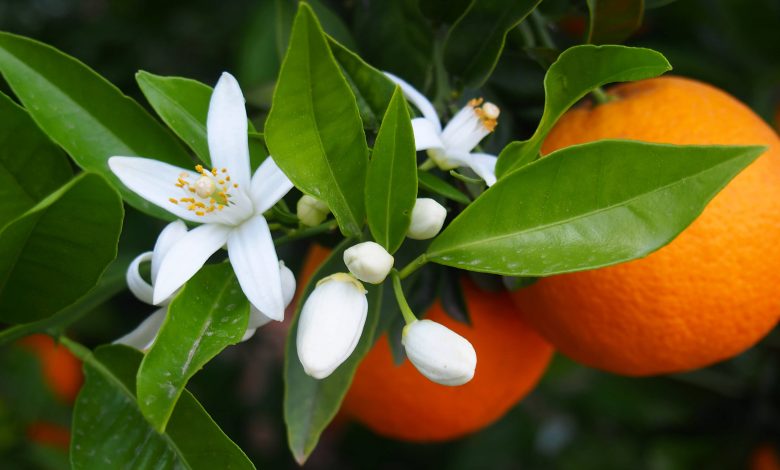Does your mozzarella refuse to stretch or just burn? The secret is science. From "pasta filata" to the crucial role...
Unraveling the Mystery Behind the Aroma of Citrus Honey
The Secrets Behind the Unique Aroma of Citrus Honey
Introduction
Citrus honey is a fragrant, nutritious, and amazing honey. Orange blossom honey is one of the flagships of pure Iranian honey. This honey has the pleasant scent of orange blossom. We enjoy its scent, but what is the reason for this pleasant scent? In this post, we will be with you with the introduction of orange blossom honey and its special aroma and flavor. Please stay with us until the end of the articles to review the reason for the pleasant scent of this popular honey.
Citrus honey is the result of the nectar of the blossoms of citrus trees such as orange, tangerine, lemon, grapefruit, lime, and many others. This honey has many fans due to its pleasant taste and aroma. If you are looking for a delicious and healthy honey, citrus honey is a good option for you. You can use this honey raw or as a sweetener in a variety of foods and beverages. Citrus honey is a versatile honey that can be enjoyed in many ways. It is a great addition to breakfast, desserts, and even savory dishes. If you are looking for a new honey to try, citrus honey is a great choice.
What is Citrus Honey?
Citrus honey is derived from the nectar of blossoms of citrus trees such as orange, tangerine, lemon, grapefruit, and lime. This honey is widely loved for its delicate sweetness and captivating aroma. Whether enjoyed raw or used as a natural sweetener in food and beverages, citrus honey is a versatile choice. It enhances breakfast dishes, desserts, and even savory meals, making it a must-try for those seeking a new honey experience.
Leading Producers of Citrus Honey
Citrus honey is produced in various regions worldwide, with Iran, Spain (Granada), and Italy (Sicily, Calabria) leading the way. Other notable producers include Israel, the United States (Florida, Southern California, Texas, Arizona), Brazil, and Mexico.

Primary Producers of Citrus Honey: Iran, Spain (Granada) and Italy (Sicily, Calabria), but also Israel, United States (Florida, Southern California, Texas, Arizona), Brazil, and Mexico.
Characteristics of Citrus Honey
Citrus honey ranges in color from white to light yellow, sometimes leaning toward amber. It boasts a medium-intensity fragrance with floral notes resembling fennel and fresh fruit blossoms. This honey is mildly sweet, with no bitterness—except in some Shiraz varieties, where unique local flora imparts a slightly bitter taste. Its acidity is low, though exposure to air may increase its acidity over time. The crystallization rate is moderate, forming fine crystals. The sucrose content generally remains below 3% but may exceed 5% in some cases.
Secrets of Citrus Honey's Aroma
The Role of Citrus Blossoms
Citrus trees, particularly orange, lemon, and grapefruit, produce highly fragrant flowers that transfer their aromatic compounds into the nectar. The resulting honey captures these volatile components, creating a rich and characteristic scent profile.
| Attribute | Value | Attribute | Value |
|---|---|---|---|
| Color Intensity | Very bright white | Glucose | 31.4 ± 2.1 g/100g |
| Sweetness | Moderate | Fructose + Glucose | 70.1 ± 3.5 g/100g |
| Bitterness | Absent | Fructose / Glucose Ratio | 1.24 ± 0.12 |
| Acidity | Weak | Glucose / Water Ratio | 1.92 ± 0.15 |
| Permanence / Taste | Short to medium | Water Content | 16.6 g/100g |
| Crystallization Rate | Medium, fine crystals | pH | 3.8 |
| Electrical Conductivity | Low | Specific Pollen | 18.6% |
| Free Acidity | 14.3 ± 3.2 meq/kg | Vitamin Content | Low to Moderate (Variable) |
| Diastase | Low | Antioxidant Activity | Low (Units may vary) |
| Invertase | 40 U/kg | Proline Content | 769 ± 157 mg/kg (Greece) |
| Fructose | 38.7 ± 2.6 g/100g |
Key Aromatic Compounds
- Linalool – Provides a floral and slightly spicy scent.
- Limonene – Imparts a fresh, citrusy note reminiscent of orange peels.
- Geraniol – Adds a sweet and rosy fragrance.
- Terpenes – Enhance the complexity of the honey’s aroma, making it more vibrant and long-lasting.
- Citrals – Responsible for the characteristic lemony scent in honey from lemon blossoms.
Influence of Environmental Factors
The aroma of citrus honey is influenced by various environmental elements:
- Climate – Warm temperatures enhance nectar production and aroma concentration.
- Soil Composition – Nutrient-rich soils contribute to the development of aromatic compounds in citrus flowers.
- Pollination Dynamics – The activity of honeybees in different citrus orchards affects the nectar mix and, consequently, the final honey aroma.
Impact of Harvesting and Processing
The way citrus honey is harvested and processed plays a crucial role in preserving its delicate aroma:
- Early Harvesting – Ensures a high concentration of floral notes.
- Minimal Heating – Prevents the loss of volatile compounds.
- Cold Extraction Methods – Help maintain the honey’s natural scent and flavor.

Amazing properties of citrus honey
Qualitative Characteristics of Citrus Honey
Color, Flavor, and Texture
- Color – Ranges from light golden to pale amber, sometimes with a slight orange hue.
- Flavor – A perfect balance of sweetness with subtle citrus undertones.
- Texture – Smooth and slightly viscous, making it easy to spread and mix.
Nutritional and Therapeutic Benefits
Citrus honey is packed with nutrients and health benefits:
- Rich in Antioxidants – Helps fight oxidative stress and supports immunity.
- Natural Antibacterial Properties – Beneficial for wound healing and throat infections.
- Supports Digestion – Acts as a natural prebiotic to promote gut health.
- Relieves Cold and Flu Symptoms – The antimicrobial and soothing properties help ease sore throats and coughs.
- Reduces Inflammation – Contains flavonoids and phenolic compounds that help alleviate inflammation and support joint health.
How to Identify Genuine Citrus Honey
To ensure you’re purchasing authentic citrus honey:
- Check the Label – Look for botanical origin certifications.
- Perform a Smell Test – Genuine citrus honey has a distinct floral-citrus aroma.
- Crystallization Test – Pure citrus honey crystallizes over time but maintains a smooth consistency.
- Taste and Texture – Authentic citrus honey has a smooth, slightly tangy taste with a hint of citrus zest.
Practical Tips
Storage Tips to Preserve Aroma and Quality
- Store in a cool, dark place away from direct sunlight.
- Keep honey in an airtight glass container to prevent exposure to moisture and air.
- Avoid excessive heat, as it can degrade the aromatic compounds.
Applications of Citrus Honey
Citrus honey can be used in various ways:
- Culinary Uses – Perfect for drizzling over yogurt, pancakes, or incorporating into dressings and marinades.
- Traditional Medicine – Used in herbal teas to soothe sore throats and boost energy levels.
- Beauty Treatments – A natural ingredient in face masks and hair treatments for its moisturizing and antibacterial properties.
Scientific Insights
Scientific studies have confirmed the various health benefits of citrus honey:
- Antioxidant Properties – High levels of polyphenols protect against oxidative stress.
- Antibacterial Effects – Effective in combating bacterial infections.
- Cognitive Benefits – Supports brain function and reduces neurodegenerative disease risks.
Conclusion
Citrus honey’s enchanting aroma results from a combination of floral nectar, key aromatic compounds, environmental factors, and careful processing methods. Its unique scent, delightful taste, and numerous health benefits make it a prized choice for honey lovers.
Specific markers of citrus honey
Citrus honey, like other honeys, has its own indicators that are used to identify and evaluate its quality. This honey has a unique aroma and taste that is created due to the presence of certain compounds in the nectar of citrus flowers. Specific indicators of citrus honey are substances found in this honey and can be used to identify and evaluate its quality. Among these markers are methyl anthranilate, hesperidin, apigenin, etc. Citrus honey indicators can be used to identify and evaluate the quality of this honey. Each of these markers indicate the quality and authenticity of honey. We will explain these compounds in more detail in the following material.
Methyl anthranilate
Methyl anthranilate is a chemical compound found in citrus honey. This compound is responsible for the fruity and grape flavor of Concord citrus honey.
The amount of methyl anthranilate in citrus honey must be at least 2 mg/kg for the honey to be recognized as an authentic citrus honey.
In a study of citrus honey samples produced in Italy, the amount of methyl anthranilate was less than 2 mg/kg. This may be due to climatic or genetic differences in Italian citrus trees.
Some European laboratories require a minimum of 2 mg/kg of methyl anthranilate to accept citrus honey.
Hesperitin
is a flavonoid found in citrus honey. This compound is responsible for the citrus flavor and aroma of citrus honey and also has antioxidant, anti-inflammatory and antimicrobial properties.
The amount of hesperitin in citrus honey varies depending on the type of citrus, production area and weather conditions. In general, citrus honey from spring oranges, oranges and lemons contain higher amounts of hesperitin.
Citrus honey produced in Iran has a high amount of hesperitin. According to a study, the average amount of hesperitin in Iranian citrus honey is 3.1 mg/kg. This amount is higher compared to other countries.
Therefore, Iranian citrus honey can be a rich source of hesperitin. This compound can help protect the body against free radical damage, inflammation and infection.
caffeine
The amount of caffeine in citrus blossom honey is less than 4 mg/kg. This amount is much less than decaffeinated coffee, which contains about 20 mg of caffeine per cup.
The presence of caffeine in orange blossom honey can be The presence of caffeine in the nectar of orange blossoms. Caffeine is a natural compound found in many plants.
The presence of caffeine in orange blossom honey does not have much effect on the properties and taste of this honey. This honey is still a natural and healthy product that can help improve body health.
Why citrus honey is so fragrant?
Citrus honey is aromatic; Because it has different chemical compounds that are produced from the nectar of the flowers of citrus trees such as oranges, tangerines and lemons. These compounds include terpenes, alcohols, aldehydes, esters, furanones and lactones, each of which has a specific and irritating smell. Some of these compounds are known as botanical markers of citrus honey, and others have been reported for the first time in honey.
- Linalool: an alcoholic terpene with a floral and woody odor. is dominant in citrus flowers. Linalool increases the intensity and diffusion of the honey aroma.
- Linalool Acetate: It is an ester with a floral and green smell that is dominant in citrus flowers. Linalool Acetate increases the intensity and diffusion of the honey aroma.
- Lavender Lactone: A lactone with a cool and fresh smell that is dominant in citrus flowers. Lavender lactone increases the intensity and diffusion of the honey aroma. Lilac aldehyde: a group of aldehydes with a floral and sweet smell that are dominant in citrus honey extract. Lilac aldehyde is the strongest indicator of citrus honey.
- Dehydroxylinalool oxide: two isomers, syn and trans, with cedar and green odor, are present in citrus honey extract. Dehydroxylinalool oxide has been reported for the first time in honey.
- So we discovered the secret of citrus honey aroma.
The extraordinary benefits of citrus honey
Citrus honey is one of the natural and delicious products that has many healing properties. This honey is the result of bees processing the nectar of orange flowers. Spring orange honey has a light yellow color, mild taste and pleasant aroma. The nature of this honey is warm and it is suitable for cold people.
Soothing and relieving anxiety and improving sleep
One of the important properties of spring honey is its positive effect on the body's nervous system. The scent of orange and orange blossoms is very pleasant and has a calming effect. Consumption of this honey helps to treat insomnia, depression, heart palpitations and headaches caused by tension. Also, it helps to strengthen the nerves, relieve colic, invigorate and relieve sadness and depression.
Some of the scientific mechanisms behind the calming and anti-anxiety effects of spring orange honey are:
Increasing serotonin levels: Serotonin is a happy hormone that is produced in the brain. Serotonin reduces depression, improves memory, improves sleep, and reduces the desire for alcohol. Spring orange honey contains tryptophan, an essential amino acid that is a precursor to serotonin in the brain. Also, spring orange honey contains flavanols that increase the level of serotonin in the brain.
Increase the level of gamma amino butyrate (GABA): GABA is a neurotransmitter (nerve messenger) that causes Relaxation and balance become central in the nervous system. GABA reduces the activity of excitable and excitable neurons and helps control anxiety, restlessness, heart rate and blood pressure. Spring orange honey contains flavonoid glycosides that increase the level of GABA in the brain.
Increasing the level of antioxidants: Antioxidants are substances that prevent oxidative stress and nerve cell damage against free radicals. be. Oxidative stress reduces the level of serotonin and GABA and increases the level of cortisol (stress hormone), which leads to anxiety, depression, insomnia and the occurrence of neurological diseases such as Alzheimer's and Parkinson's. Spring orange honey contains strong antioxidants such as flavonoids, vitamin C, and anthocyanin, which are useful in preventing oxidative stress and maintaining nerve health.
Strengthening the heart and blood purification
One of the important properties of spring orange honey is its positive effect on the cardiovascular system. Spring orange honey strengthens the heart, lowers blood pressure, purifies the blood and prevents the occurrence of cardiovascular diseases such as atherosclerosis (fat deposits in the arteries) and heart attack.
Some scientific mechanisms behind the strengthening effects The heart and blood purifier of Baharnaranj honey are:
Reduction of blood fats: Baharnaranj honey has antioxidant and anti-inflammatory properties that reduce the level Total cholesterol, LDL cholesterol (bad cholesterol), triglycerides (blood fat) and apolipoprotein B (fat carrier protein) in the blood. Also, this honey increases the level of HDL cholesterol (good cholesterol) in the blood. . These changes improve the ratio of total cholesterol to HDL cholesterol and reduce the risk of cardiovascular diseases.
Increasing nitric oxide: Nitric oxide is a chemical substance that is produced in the walls of blood vessels. It causes blood vessels to dilate and blood pressure to decrease. Spring orange honey contains tryptophan, which is an essential amino acid and is a precursor of nitric oxide in blood vessels. Also, spring orange honey contains flavanols that increase the level of nitric oxide in the blood vessels.
Decreasing blood coagulation: Blood coagulation is a physiological process that causes the formation of blood clots at the wound site. Bleeding is prevented. But if blood coagulation is too much, it may cause blood clot formation in the veins and blockage of blood flow to the heart and brain, which leads to heart attack and stroke. Spring orange honey has anti-coagulant properties that reduce the activity of blood platelets (cells that play a role in blood coagulation) and prevent the formation of blood clots in the veins.
Help to digestion
Increasing the secretion of digestive enzymes: Citrus honey increases the production and secretion of digestive enzymes in the digestive system, which helps to break down and absorb Better food helps. Digestive enzymes include amylase (to break down starch), lipase (to break down fat), peptidase (to break down protein) and lactase (to break down lactose).
Increasing intestinal activity: Citrus honey increases bowel movements and bowel emptying, which helps to cleanse the bowels and prevent constipation and hemorrhoids. Also, citrus honey reduces intestinal inflammation and adhesions and treats irritable bowel syndrome (IBS) and the occurrence of permeable bowel syndrome (IBD) such as Crohn's and conjunctivitis colitis.
Increasing intestinal flora: b> Citrus honey improves the balance of intestinal flora and increases the level of probiotics (beneficial bacteria) in the intestine. Probiotics strengthen the immune system, reduce inflammation, produce nerve growth factor (NGF) and improve blood levels, and help prevent many of the effects induced by alcohol12. Citrus honey also reduces the level of harmful bacteria such as Helicobacter pylori (H. pylori), which causes stomach and duodenal ulcers.
Healthy skin
One of the important properties of spring honey is its positive effect on the skin of the face and body. Some of the positive effects of spring orange honey on clear and healthy skin are:
increasing skin collagen: Orange contains vitamin C, which is one of the most important antioxidants in the body. Vitamin C increases skin collagen production. Collagen is an important protein for the skin that causes skin rejuvenation, elasticity and transparency. Also, collagen prevents wrinkles, blemishes and skin darkening.
Antifungal and antibacterial: Spring orange honey has antifungal and antibacterial properties. Is. These properties prevent the growth of harmful fungi and bacteria on the skin. Also, spring orange honey treats boils, acne, inflammation, and skin wounds. Hydrating and moisturizing: Spring orange honey has hydrophilic properties. . This feature absorbs moisture from the air and preserves water in the layers of the skin. Also, spring orange honey nourishes and softens the skin.
Reduces the effect of alcohol poisoning.
Honey is one of the natural and delicious products that has therapeutic properties in the treatment of alcoholic patients. One of the properties of citrus honey is helping to quit alcohol and prevent its side effects. Some of the positive effects of citrus honey on alcohol withdrawal are:
- increasing the release of ethanol from the blood: citrus honey increases the level of blood ethanol secretions and reduces the time and level Alcohol poisoning helps. Citrus honey also reduces the activity of the aldehyde dehydrogenase (ALDH) enzyme, which plays an important role in breaking down and draining ethanol.
- Increasing natural antioxidants: Citrus honey is rich in natural antioxidants that help Preventing oxidative stress and damage of liver cells against free radicals help. Antioxidants in citrus honey include flavonoids and vitamin C.
- Increases serotonin levels: Citrus honey increases serotonin levels in the brain, which is a happy hormone. Serotonin helps to reduce depression, improve memory, improve sleep and reduce the desire for alcohol.
- Increasing the level of probiotics: Citrus honey improves the balance of intestinal flora and increases the level of probiotics in the intestine. it will be Probiotics strengthen the immune system, reduce inflammation, produce nerve growth factor (NGF) and improve blood levels and help prevent many of the symptoms induced by alcohol.
 Orange blossoms
Orange blossoms
Effect of storage on chemical composition and sensory properties of citrus honey
Storage of citrus honey can affect its chemical composition and sensory properties. At the end of the material, we will discuss some of these changes, especially in the aroma of this honey. Citrus honey can easily be changed. Storage conditions are very influential on the quality of honey. High temperature and sunlight cause chemical reactions in honey, which lead to decrease in diastase activity, increase in HMF, change in color, decrease in volatile compounds, change in smell and taste, and decrease in sensory properties of honey. Unlike high temperature, low temperature preserves the sensory properties of honey, but at the same time causes the sugars in honey to crystallize.
Some effects of storage on citrus honey include:
Colour change: The color of citrus honey darkens with time. This color change is due to the increase in the level of phenolic compounds, pollens and minerals in honey. Also, color change due to chemical and biochemical reactions such as fermentation, oxidation or dehydration of sugars, leads to changes in acid content and production of compounds such as 5-Hydroxymethylfurfural (5-HMF), which changes the sensory characteristics and quality of honey.
Taste change: The taste of honey becomes sweeter and a little bitter with time. This change in taste is due to a decrease in the level of digestible sugars (glucose and fructose) and an increase in the level of insoluble sugars (difructose) in steppe honey. Also, the change in taste occurs due to increased levels of 5-HMF, which is a compound with a bitter taste.
Changing aroma and smell: The honey smell of the compounds decreases a little with the passage of time and becomes a little more caramel. This change in smell is due to the decrease in the level of volatile compounds in honey. Volatile compounds are responsible for the specific smell of honey and originate from different flowers. Also, the change in smell occurs due to the increase in the level of 5-HMF, which is a compound with the smell of caramel. Proper storage conditions should be observed. The best conditions for storing honey are 5 degrees Celsius and low light. In this situation, honey not only maintains its sensory characteristics, but also will not undergo any chemical changes. Also, proper packaging of honey plays an important role in preventing its dehumidification and oxidation. Therefore, store honey in glass or plastic containers with tight lids.
Leave a comment
Log in to post comments
Related posts
 Why does pollen improve your health?
Why does pollen improve your health? 10 Ways to Consume Bee Pollen
10 Ways to Consume Bee Pollen



















Latest comments